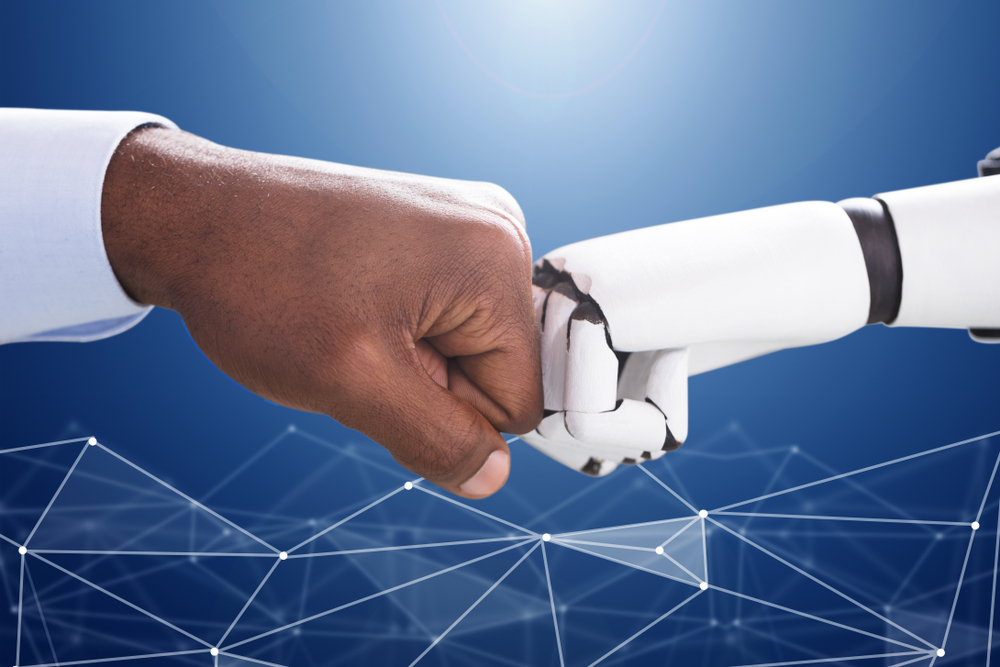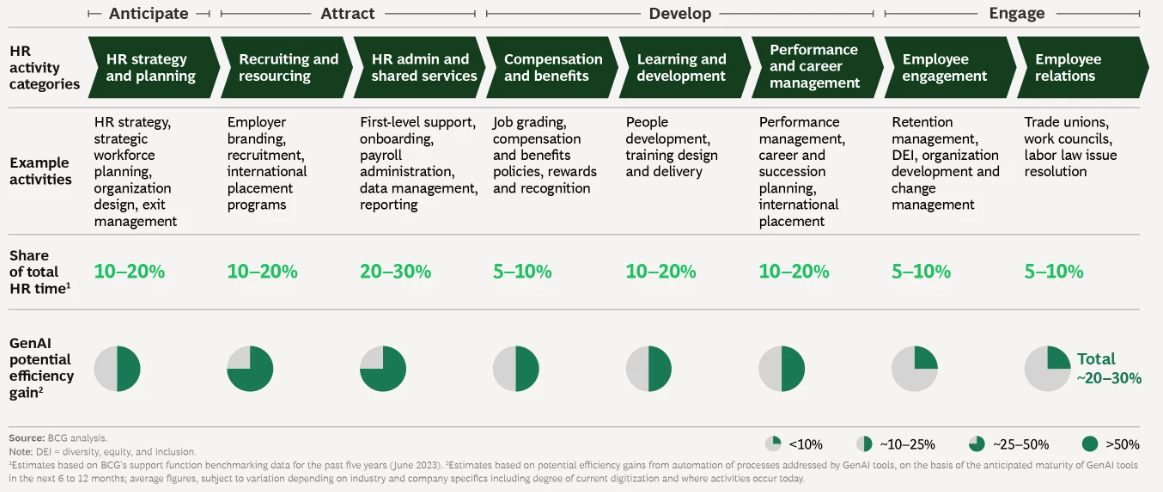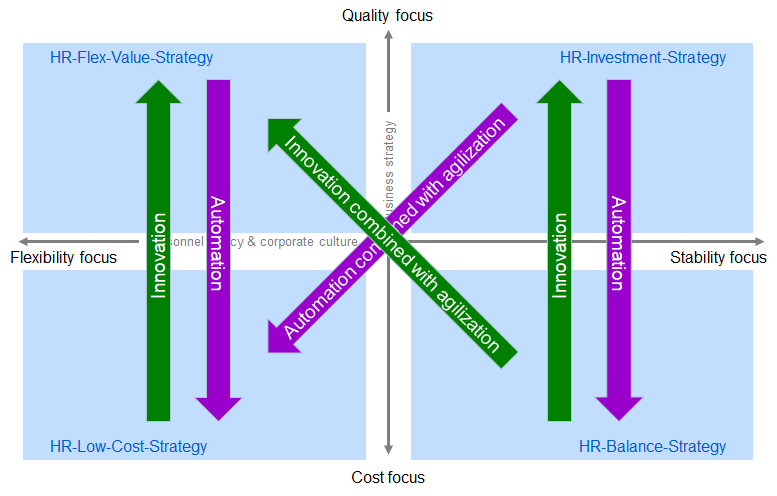Application areas of generative artificial intelligence, or GenAI for short, are often examined from a technical perspective. With regard to HR, automation, recruiting and the evaluation of employee data are often mentioned. That´s all? This article takes a different perspective.
Generative AI is a form of artificial intelligence that generates new content based on instructions and existing information. AI methods and technologies such as trained neural networks, machine learning (deep learning) and AI algorithms are used to generate texts, images, audio and video content, program code, 3D models and more according to instructions.
Well-known examples of GenAI are large language models for generating text such as GPT-3 or GPT-4 and the ChatGPT chatbot based on them, or image generators such as Stable Diffusion, Midjourney and DALL-E.
In this article I deal with the topic of GenAI from the perspective of an HR strategy.
GenAI – also in HR
The latest annual McKinsey Global Survey on the current state of AI confirms the explosive growth of generative AI tools. Interesting findings for business and HR professionals alike are:
- AI high performers are more than three times more likely than others to say their organizations will retrain more than 30 percent of their workforce in the next three years due to AI adoption.
- High performers in GenAI are less likely to see cost reduction as their ultimate goal for generative AI efforts.
- AI high performers are most likely to cite models and tools as their biggest challenge. In comparison, other respondents cite strategy issues, such as establishing a clearly defined AI vision linked to business value or finding sufficient resources.
An excellent BCG article from August this year sums up the enormous impact of generative AI on the HR function: Generative AI has done what no other technology trend has: accelerate HR’s engagement with artificial intelligence. GenAI has the potential to drive about 30 % increased productivity across the HR value chain in the near term.
In the BCG scenario, GenAI transforms HR into a more strategic function with the following implications:
- Significantly increased self-service,
- significant productivity and experience improvements,
- truly personalized, always-on delivery of HR services, and
- a comprehensive, data-driven talent ecosystem.
How can these potentials be “leveraged” in the best possible way? I outline this in the following paragraph.
GenAI from an HR strategy perspective
On the one hand, GenAI has an impact on the business areas of an organization – and therefore on its workforce. HR has to assume resulting responsibilities. On the other hand, HR as a business unit itself is affected by GenAI. These developments lead to a transformation of HR core strategies. I discussed the four HR core strategies, among others, in an earlier blog post. Automation (focus: efficiency, costs) and innovation (focus: effectiveness, quality) initiated by GenAI lead to shifts in HR core strategies.
Accordingly, a company in the investment strategy quadrant will have the ambition to pursue a GenAI or digitization strategy that supports quality orientation without neglecting efficiency-driven cost savings. According to Josh Bersin, this could include the following applications:
- Creating competency inventories and candidate profiles for recruiting,
- Performance management and feedback,
- coaching and leadership development,
- mental health and well-being, as well as
- HR self-service and knowledge management.
Impact on HR competencies
Digitization in general and GenAI in particular are becoming key drivers of current and future changes in the skills landscape for many occupational fields. Numerous publications, e.g. from Hays, WEF, PwC and STRIM, deal with key competencies and/or digital competencies that will be required in the future.
Gery Bruederlin correctly links the necessary future digital HR competencies to the respective HR core strategy:
- The HR strategy represents the first essential determining factor of digital HR competencies.
- Digital HR competencies are ultimately dependent on three mutually influencing factors: HR strategy-related, structure-related and technology-specific.
- According to current knowledge, digital HR competencies primarily affect processional competencies and social-communicative skills, while personal and action-oriented competencies – see CompetenceAtlas – remain equally relevant regardless of technological developments and are therefore hardly affected by GenAI.
- When it comes to subject-specific skills, the focus is on analytical skills (data management) among the generic specialist skills, recruitment and talent management among the specific core specialist skills, financial skills among the business-related specialist skills, and communication and cooperation among the social-communicative skills.
The HR role hierarchy is becoming increasingly demanding across the four HR core strategies – HR-Low Cost, HR-Balance, HR-Fex Value, HR-Investment! In the latter strategy, the role of digital product and process innovator includes 13 key HR competencies, the role of agile strategy partner 16.
Impact on the HR structure
An HR TOM or an HR structure cannot succeed – as already explained elsewhere – without a prior HR strategy! After intensive engagement with HR core strategies, the competencies and roles of the HR department must be aligned with the HR strategic fields of action.
Gery Bruederlin concludes: It is not only the digitaliization of HR that helps determine the organizational form of the HR function by means of automation, innovation and flexibilization strategies, but it is also the digitalization and flexibilization of the company and its relevant business areas that determines the business-specific orientation of the HR function in terms of content and can thus trigger structural shifts towards business-focused HR organizations.
When automation is the focus with GenAI, this is generally accompanied by a smaller need for required HR employees and an increased degree of centralization of the HR organization. As a result, this means a shift in power from the HR Business Partners to the HR Shared Services.
If, on the other hand, the focus is on innovation, this is usually accompanied by a different and possibly broader need for competencies and an increased degree of decentralization of the HR organization. As a result, this can lead to an upgrading of the Center of Expertise and a decentralizing shift of power towards HR Business Partners.
Conclusion
Automation-driven HR digitization or the integration of GenAI is primarily about efficiency gains and thus a high cost focus of digitization-related measures. However, if the purpose of HR digitization is innovation-driven, then the goals of HR activities are to be found in the area of effectiveness gains. Accordingly, the primary focus is on a quality-oriented strategy.
The intensive pursuit of “innovation” through investments in modern and quality-enhancing tools and functionalities opens up new dimensions for the value-adding orientation of HR functions.
Behnam Tabrizi and Babak Pahlavan advocate that companies “go on the offensive” with AI and prioritize increasing innovation, agility and productivity – thereby protecting jobs. This will help companies find the right mix of automation and innovation, harness the potential of GenAI in terms of productivity gains, and build necessary skills to a sufficient extent.
This implies a different perspective, namely not coming via the technical possibilities, but via the HR core strategies, their impact on HR competencies and roles, as well as on the HR structure.




Leave A Comment